North Carolina is home to hundreds of spider species, though only 4 are considered venomous and dangerous to humans.
Most spiders, including venomous ones, are not usually aggressive towards humans. In fact, they are more scared of you than you are of them and they will only bite if provoked.
Table of Contents
Venomous Spiders in North Carolina
1. Southern Black Widow
Scientific name: Latrodectus mactans.
Common name: southern black widow, simply black widow, shoe-button spider.
The Southern black widow is one of the most well-known venomous spiders in North Carolina growing up to 0.51 inches (13mm) in body length for females and 0.24 inches (6mm) for males.

Females are venomous spiders. She is usually shiny black with a red hourglass on her belly and a bulb-shaped abdomen. Many of the female black widows also have orange or red just above the spinneret on the top of her abdomen.
Males, which are not considered venomous, are purple or gray-black in color.
Even though the Southern black widow is famous for its venom, the female injects a venom that varies from one to the next. The venom binds to the neuromuscular receptors.
Human fatality from a black widow bite is very rare with no deaths recorded with more than two thousand black widow bites each year.
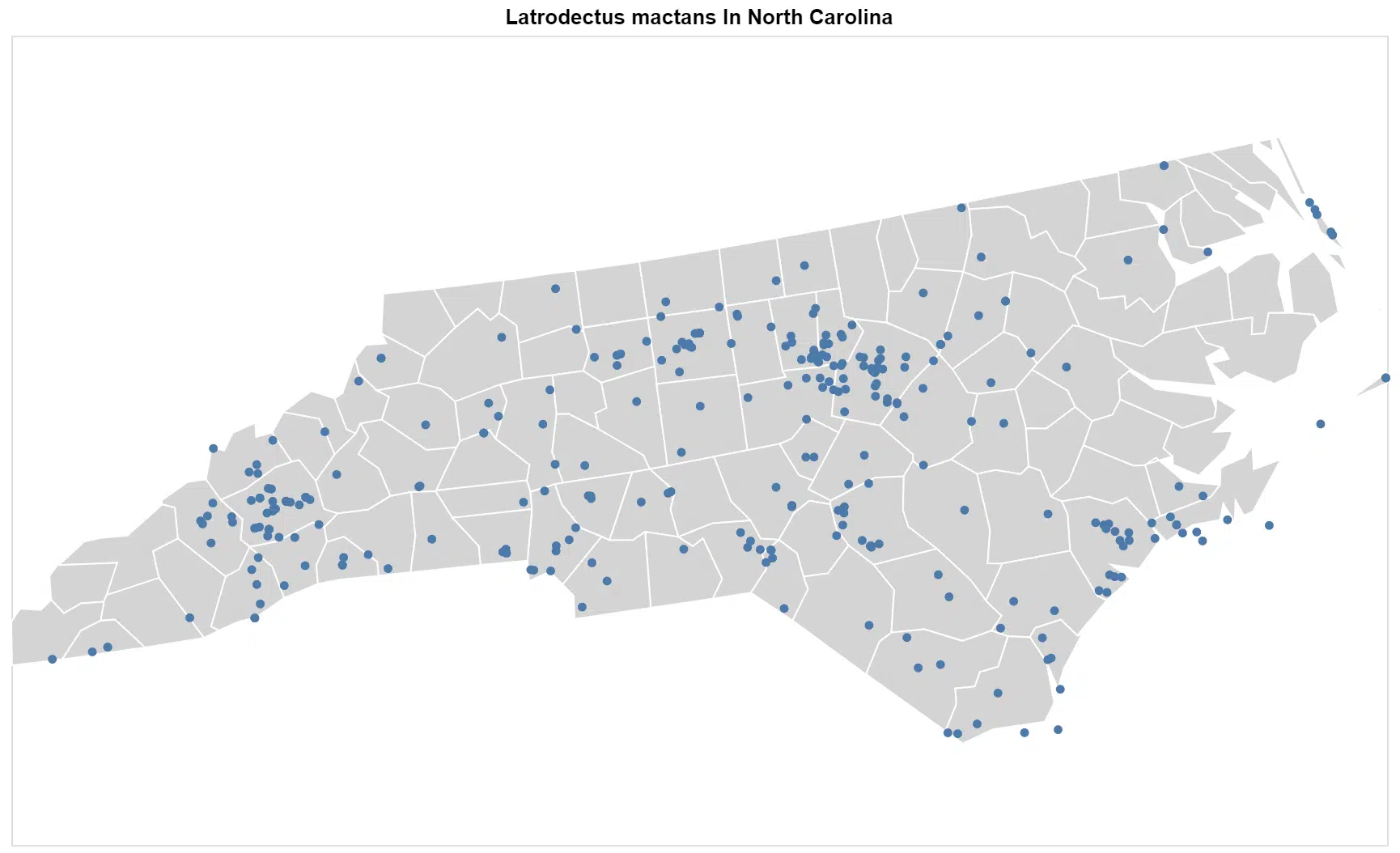
The Southern black widow can be found throughout North Carolina though they are more common in the Piedmont and Mountains areas.
2. Northern Black Widow

Scientific name: Latrodectus variolus.
Common name: northern black widow spider, northern widow.
The Northern black widow is closely related to the Southern black widow. This glossy black spider has red circles on the backside with a broken red hourglass on the belly.
The broken red hourglass is what can help you distinguish the Southern and Northern black widows.
The female’s venom is toxic, but not as dangerous as the Southern black widow.
Bites from Northern black widows have low mortality, most fatalities being small children. Bites are considered a medical emergency.
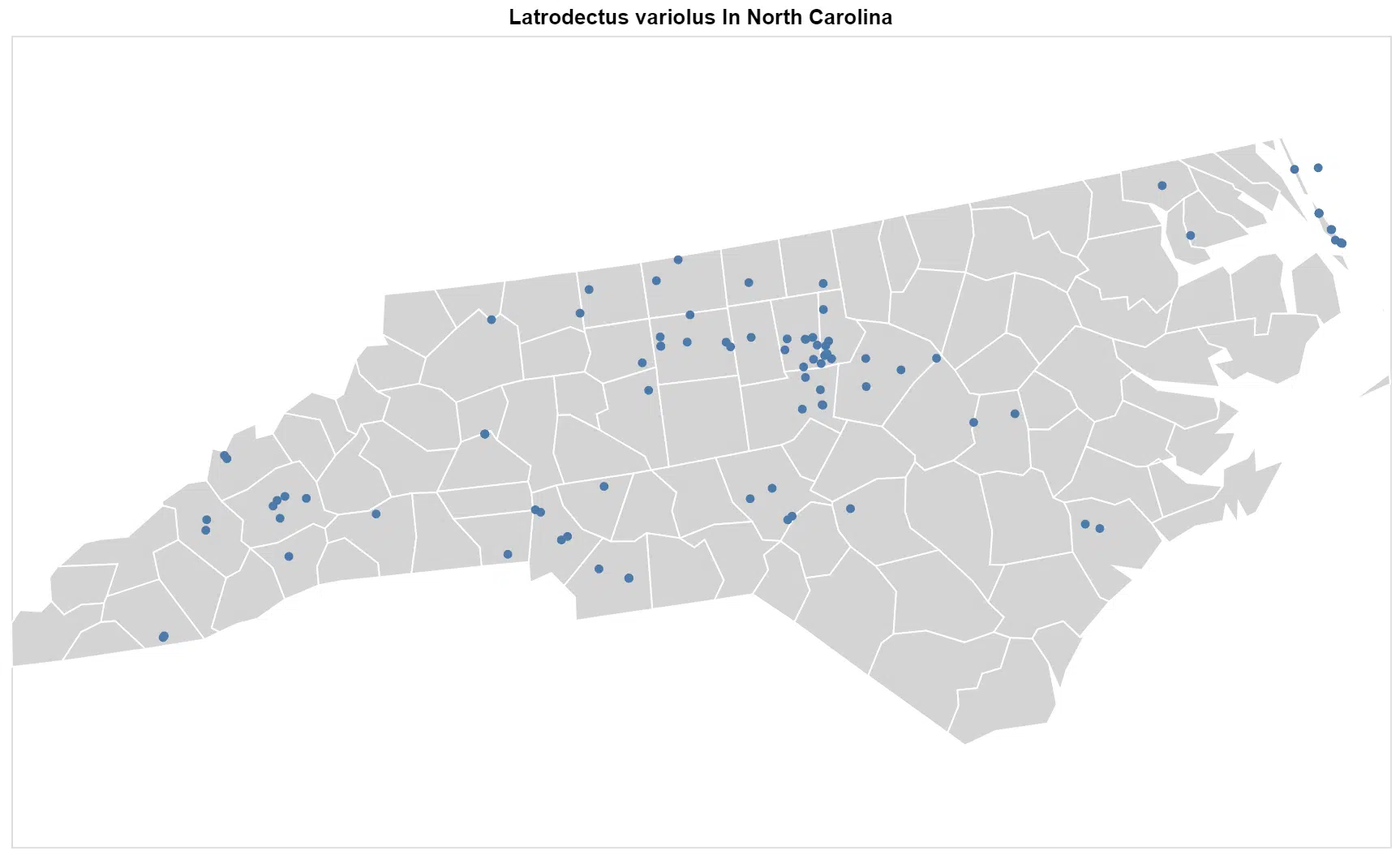
Northern black windows are often encountered in garages, barns, and sheds, where they are mostly active at night and seldom seen during the day.
3. Brown Widow

Scientific name: Latrodectus geometricus.
Common name: brown widow, brown button spider, grey widow, brown black widow, house button spider, geometric button spider.
The brown widow is smaller and lighter in color than the black widows. They range in color from dark brown to black to a tan color, some have shades of gray.
They also have an hourglass marking on their belly, which is orange or yellow. This is what can help you distinguish between the black and brown widow, the black widow has a bright red hourglass.
The brown widow also has a black and white pattern on the dorsal side of their abdomens, along with stripes on the legs.
They have a neurotoxic venom that acts on nerve endings. Their bites are not very dangerous and are not considered as dangerous as the black widow.
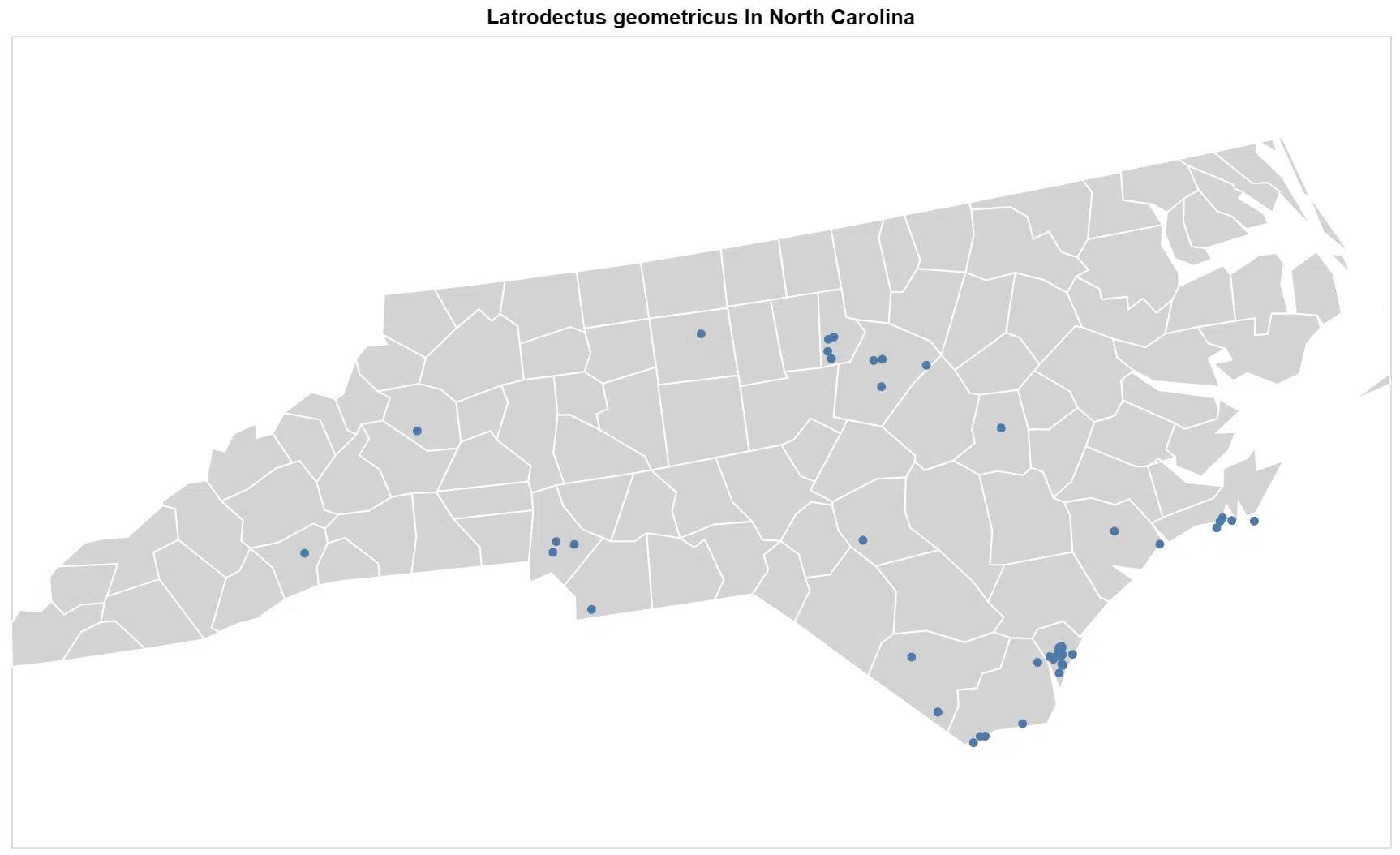
The brown widow is considered a relatively new species in North Carolina and is not as common as the black widows.
4. Brown Recluse

Scientific name: Loxosceles reclusa
Common name: brown recluse, fiddleback spider, brown fiddler, violin spider.
The brown recluse, also known as the violin spider, often has similar patterns and markings to the cellar spider.
Unlike other spiders, the brown recluse has six eyes, which are arranged in pairs.
The violin marking can vary, based on the age of the spider with older spiders having a darker violin marking. The violin points towards the bulb-shaped abdomen.
There are no patterns on the abdomen or legs.
This spider is dangerous to elderly individuals and children, in particular. Their venom can spread throughout the body within minutes. A bite from this spider is considered a medical emergency.
They are common in North Carolina, though most of them are observed in the Piedmont area towards the mountains where they remain low to the ground, often underwood, debris, and brush.
Spider Bite With Skin Reactions
Most spiders are venomous, though they are not dangerous to humans. While some have unpleasant side effects once bitten, such as the spiders mentioned above, some cause unpleasant skin reactions.
Yellow Sac Spiders

Scientific name: Genus Cheiracanthium.
Common name: yellow sac spiders.
There are two species of yellow sac spider: the Northern yellow sac spider and the Agrarian sac spider.
These spiders are pale yellow to beige and can grow to 0.4 inches (10mm) in body length. Their legs have a double claw at the end with the front pair of legs being longer than the rest.
Males are more slender and smaller than females.
Some have an orange to brown colored stripe that runs down the top of their abdomen.
They will bite if provoked and are considered mildly venomous to humans. Their bites are painful, which can cause pain, swelling, and lesions in the bite area.
They are not considered medically significant with bite symptoms being managed safely at home.
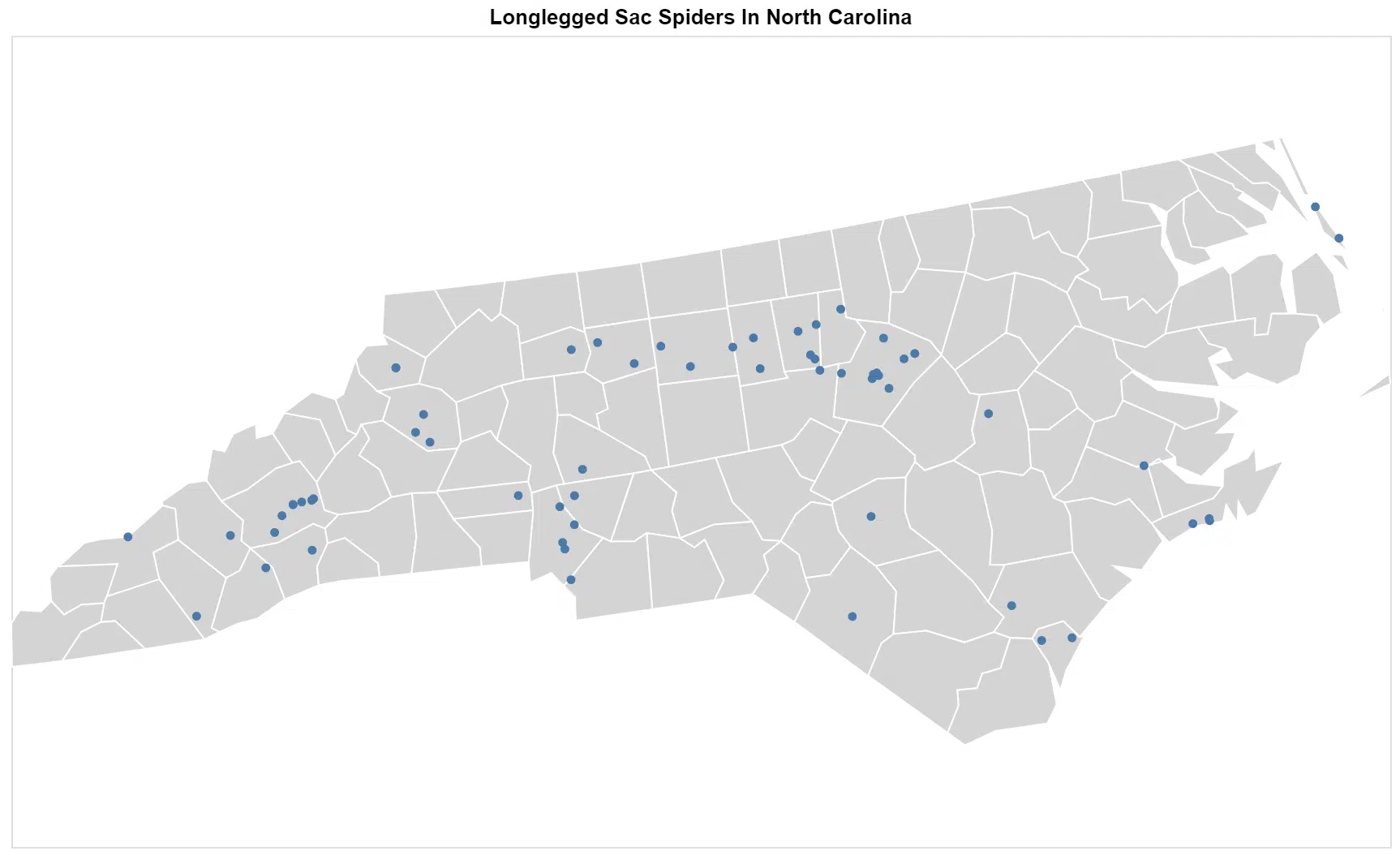
The yellow sac spider is common throughout North Carolina.
Wolf Spiders

Scientific name: Genus Lycosidae.
Common name: wolf spiders.
There are approximately thirty species of wolf spiders in North Carolina, which range in body size up to 1.38 inches (35mm) in body length.
Their eight eyes are arranged in three rows. They have reflective tissue under the four larger eyes, which helps you observe it when you shine a light at the spider.
They rely on camouflage to protect themselves and are often similar in color based on their environment.
Some of the wolf spiders make burrows, where they hide most of the time. Males sometimes wander into homes searching for a mate during the fall.
They are not considered very dangerous to humans, but they will inject venom if they bite you. This involves some pain, swelling, and itching.
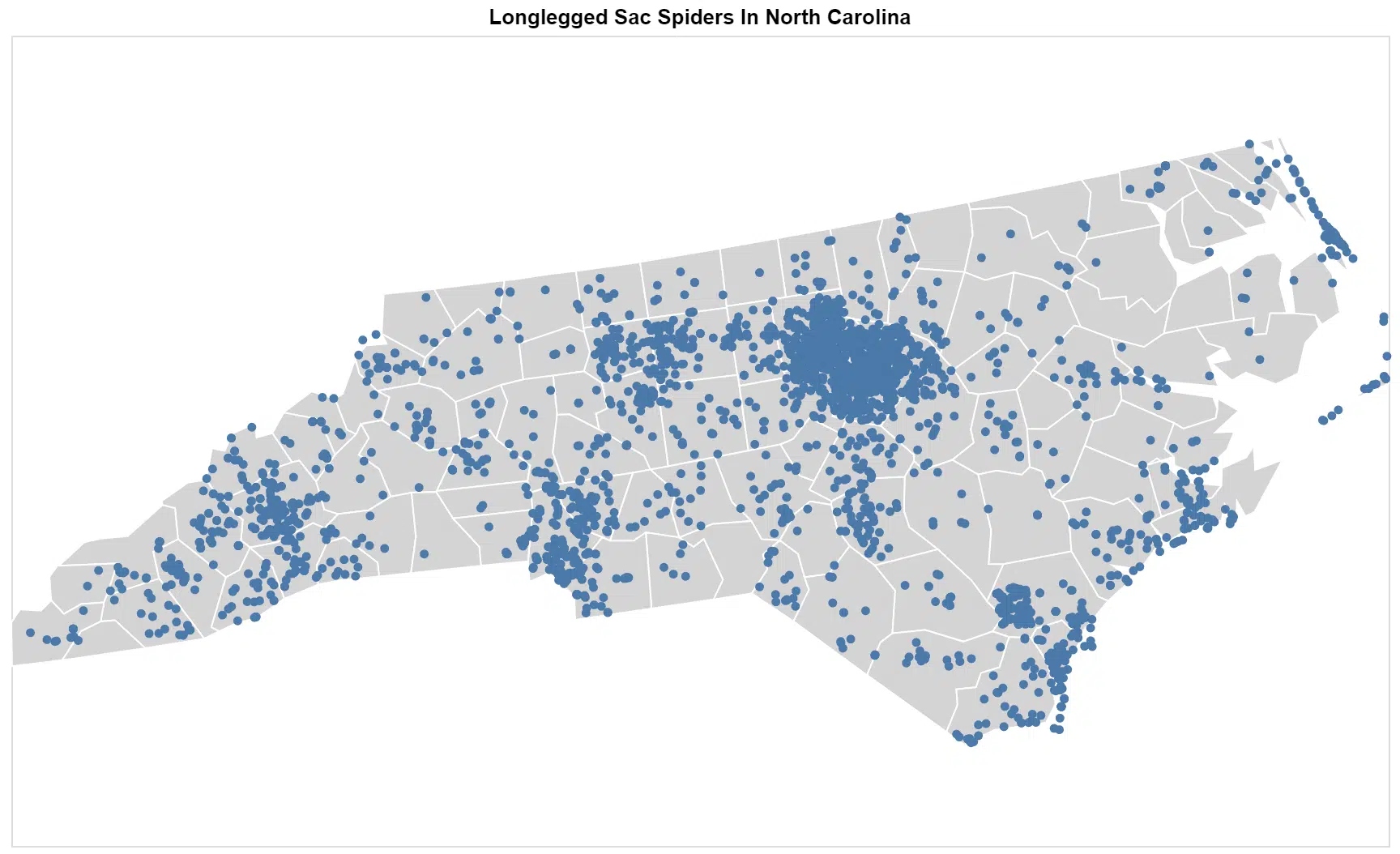
What To Do When You See A Spider In North Carolina
The first and most important thing to remember if you see a spider in your home, office, garage, or car, is do not to panic. This may be easier said than done, but remember that the majority of spiders are not dangerous and they are more scared of you than you are of them.
Spiders are very beneficial in keeping your home or property bug-free.
Chances are the spider has wandered into your home looking for their next meal or a mate. If you feel safe in doing so, you can simply capture the spider using a plastic container or jar and piece of paper, releasing it back into the wild.
If you see a spider in the wild, the best option is to observe it from a distance and leave it alone.
What To Do When You Are Bitten
The majority of spider bites are not considered a medical emergency, causing pain, swelling, and redness which can be managed at home. There are some spiders that are venomous and you should seek immediate medical attention if:
- You were bitten by a black widow or brown recluse spider
- If you are not sure what spider was or whether it was a venomous spider
- You have severe pain with the wound growing in size with stomach cramps
- Your throat and face swell, making it hard to swallow or breathe
- The bite area has spreading red streaks or the redness is spreading.
Widow Bite Symptoms
The black widow is one of the most venomous spiders in North Carolina easily identified for the red hourglass marking on the belly. Symptoms of a black widow bite include:
- Pain, swelling, and redness at the bite site
- Stomach cramping
- Nausea and vomiting
- Tremors
- Sweating
Recluse Spider Bite Symptoms
Brown recluse spider bites are categorized into groups, these include:
- Unremarkable – minimal damage and self-healing
- Mild – itching, redness, mild lesions. This is self-healing
- Dermonecrotic – a typical brown recluse bite, which causes a necrotic skin lesion. 66% will heal with no complications. In severe cases, the lesion can become 40cm in width, lasting several months and healing with a scar.
- Systemic – this is a very rare systemic reaction to the venom, often observed in children.
The majority of brown recluse bites are unremarkable or mild.

The brown recluse can be identified for the violin shape on its back. Signs and symptoms associated with a brown recluse bite include:
- Mild pain
- Body aches
- Chills
- Fever
- Deep blue or purple marking around the bite – this may develop a red ring
Treatment
In most cases, a spider bite can safely be treated at home.
If you think you have been bitten by a venomous spider or you are not sure, then seek immediate medical treatment.
If you experience any muscle spasms or pain, seek medical treatment. Your doctor will prescribe muscle relaxants and/or pain medication. They may give you a tetanus injection.
For all minor spider bites, you can:
- Clean the wound with water and a mild soap
- Apply antibiotic ointment to the area to prevent infection
- Apply a cool compress to the bite area for fifteen minutes every hour to reduce swelling and redness.
- Take an over the counter pain reliever
- If the wound becomes itchy, use an antihistamine cream or tablet
How To Prevent Spiders
It doesn’t matter where you live in North Carolina, you are guaranteed to find a spider in your home from time to time.
If you are scared and worried that your home may be an invitation to venomous spiders, there are a few things you can do to minimize the risk of a spider making its way into your space.
Some of the preventative measures you can take includes:
- Vacuum regularly – vacuum floors, under cabinets and beds, behind large furniture, and along the edge of the ceiling
- If you see any webs, vacuum them up or remove them immediately
- Fill in any openings, such as under doors, around any pipes coming into the home, or in walls.
- Move firewood, garden bags, composite piles, and general clutter away from the home.
- Cut back any bushes or trees which are touching or very close to the home
- Don’t use bright night lights that attract insects. Insects are the primary meal for the majority of spiders. Too many insects attracted to the light will be too inviting for a spider or two.
- Try some essential oils. The strong scent of certain essential oils can repel spiders, preventing them from coming into the home. Essential oils are natural and safe. Try wiping some citronella, peppermint, lavender, rose, or tea tree oil around window frames, doors, and other entryways.
Summary
With hundreds of species of spiders in North Carolina, it can be a sigh of relief that only four are considered venomous and dangerous to humans. Even the venomous spiders in North Carolina, seldom cause a fatality.
Their venom can cause unwelcome side effects, which can be dealt with quickly by a medical team.
Remember to stay away from spiders, especially if you are unsure what spider you are dealing with. Take preventative measures to reduce the number of spiders visiting your home.
Further Reading: